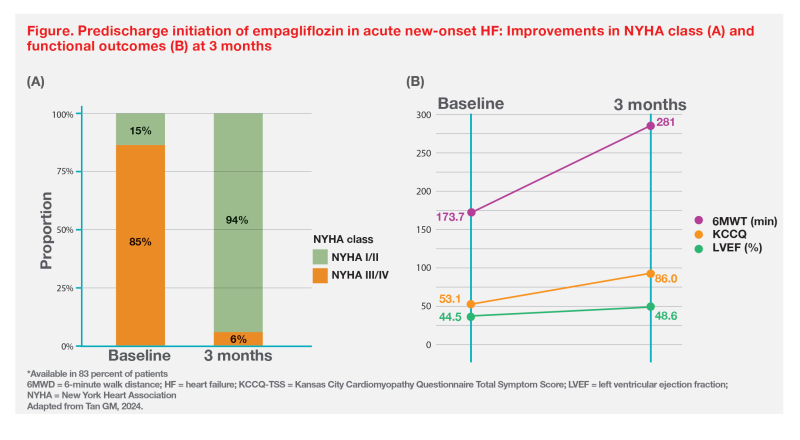PWH’s acute HF study supports predischarge initiation of SGLT2i





International heart failure (HF) guidelines emphasize early predischarge initiation of all components of guideline-directed medical therapy (GDMT), including sodium-glucose cotransporter 2 inhibitors (SGLT2i), in patients hospitalized for acute HF. In an interview with MIMS Doctor, Dr Guang-Ming Tan of the Division of Cardiology, Chinese University of Hong Kong, discussed positive results of his centre’s recent study that evaluated predischarge initiation of empagliflozin in patients hospitalized for acute new-onset HF regardless of left ventricular ejection fraction (LVEF).
CKM syndrome affects HF prognosis
Cardiovascular-kidney-metabolic (CKM) syndrome is a health disorder that stems from the close connections between obesity, diabetes, chronic kidney disease (CKD) and cardiovascular disease, including HF. [Circulation 2023;148:1606-1635]
“Thus, HF and CKD are closely linked. Progression of one CKM condition leads to worsening of the others. Early intervention may break this vicious cycle and reduce the risk of adverse complications,” he continued.
Why empagliflozin for acute HF?
“About 10 percent of acute HF patients die within 1 month after diagnosis, and about 30 percent are readmitted within 60–90 days,” said Tan. “Patients started on GDMT are shown to have >50 percent reductions in mortality and readmission vs those who are not.”
In the EMPULSE trial, initiation of empagliflozin during hospitalization for acute HF, after stabilization, was associated with a significant clinical benefit (a hierarchical composite of death from any cause, number of HF events and time to first HF event, or a ≥5-point difference in change from baseline in Kansas City Cardiomyopathy Questionnaire Total Symptom Score [KCCQ-TSS]) at 90 days vs placebo (stratified win ratio, 1.36; 95 percent confidence interval, 1.09–1.68; p=0.0054), regardless of LVEF. [Nat Med 2022;28:568- 574] This clinical benefit was associated with empagliflozin’s early and sustained decongestive effect vs placebo, as indicated by the surrogate measure of weight loss. [Eur Heart J 2023;44:41-50]
International HF guidelines now recommend SGLT2i as one of the foundational classes of GDMT, regardless of LVEF. For patients hospitalized due to acute HF, guidelines recommend predischarge initiation and titration of GDMT after stabilization. SGLT2i, being distinct from neurohormonal inhibition with minimal effects on blood pressure (BP) and kidney function, can be initiated at any time in the treatment course. [J Am Coll Cardiol 2024;84:1241-1267; J Am Coll Cardiol 2024;83:1444-1488; J Am Coll Cardiol 2023;81:1835-1878; J Am Coll Cardiol 2022;79:e263-e421; Eur Heart J 2023;44:3627-3639; Eur Heart J 2021;42:3599-3726]
PWH’s study: Empagliflozin predischarge in acute new-onset HF
“Some GDMT for HF requires LVEF assessment by echocardiography, for which the waiting time is long in Hong Kong’s public hospitals,” explained Tan. “Empagliflozin is indicated in HF irrespective of LVEF and does not require titration. Thus, it can be initiated before echocardiographic assessment becomes available.” [Jardiance Hong Kong Prescribing Information]
“We therefore conducted a prospective, open-label study at the Prince of Wales Hospital [PWH] to evaluate the 90-day efficacy and safety of initiating empagliflozin during hospitalization for acute new-onset HF, regardless of LVEF,” he said.
Between May 2023 and September 2024, 100 patients with dyspnoea plus two other signs of HF and N-terminal pro–B-type natriuretic peptide (NT-proBNP) levels ≥1,600 pg/mL were recruited during hospitalization.
At baseline, the patients’ mean age was 70.28 years, LVEF was 44.5 percent (39 percent had LVEF <40 percent), mean NT-proBNP level was 3,952.3 pg/mL, mean 6-minute walk distance (6MWD) was 173.7 m, and mean KCCQ-TSS was 53.1 +/- 22. A majority (85 percent) were in New York Heart Association (NYHA) functional class III–IV.
“Empagliflozin was initiated during hospitalization after stabilization, usually on days 2–3,” said Tan. “We evaluated clinical benefit, including all-cause mortality, hospitalization for HF [HHF], and changes in 6MWD and KCCQ-TSS from baseline, after 3 months of treatment.”
Improvements at 3 months
“At 3 months, overall mortality rate was 5 percent. None of the deaths were HF-related. HHF occurred in 13 patients,” said Tan. “Most patients recruited in this study [94 percent] were in NYHA functional class I–II at 90 days, meaning that they were asymptomatic or had mild symptoms only. Echocardiographic assessment, available in 83 percent of patients, showed a 4 percent increase in LVEF from baseline. Mean NT-proBNP level decreased by 55 percent from baseline to 1,778.6 pg/mL. Mean 6MWD improved by 61.7 percent from baseline to 281 m, and mean KCCQ-TSS improved to 86.0 +/- 15 [p<0.001].” (Figure)

GDMT attainment and safety
“In our study, GDMT attainment rate was good, with 76 percent of patients on angiotensin-converting enzyme inhibitor/angiotensin-receptor blocker/angiotensin receptor-neprilysin inhibitor, 76 percent on beta-blocker, and 51 percent on mineralocorticoid receptor antagonist at 3 months,” said Tan.
Empagliflozin was well tolerated in the PWH study. Although 30 adverse events (AEs) and 16 serious AEs were reported during the study period, only one AE (ie, urinary tract infection) and no serious AEs were considered to be related to empagliflozin.
Implications on clinical practice
“Consistent with results of EMPULSE, our study demonstrated feasibility and safety of early initiation of empagliflozin in patients hospitalized for acute new-onset HF, regardless of LVEF,” said Tan. “In these patients, empagliflozin can be initiated during hospitalization, after stabilization, before echocardiographic assessment becomes available.”
“Early initiation of all four pillars of GDMT is important to ensure optimal treatment of HF down the road,” he continued. “I usually start SGLT2i as the first drug in the GDMT regimen as SGLT2i are effective across the spectrum of LVEF, require no titration, are very well tolerated with a minimal effect on BP, have decongestive and renoprotective effects, and are associated with a decreased risk of hyperkalaemia. These may enable tolerance and uptake of other classes of GDMT for HF.” [J Am Coll Cardiol 2021;77:1408-1411]